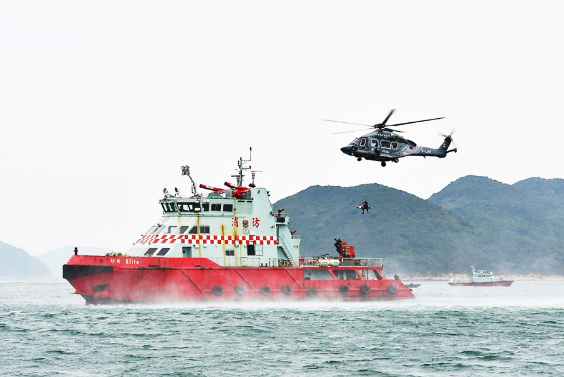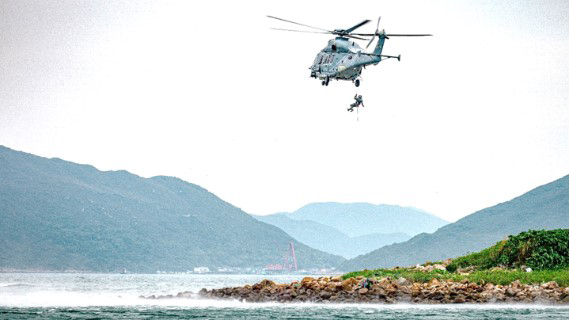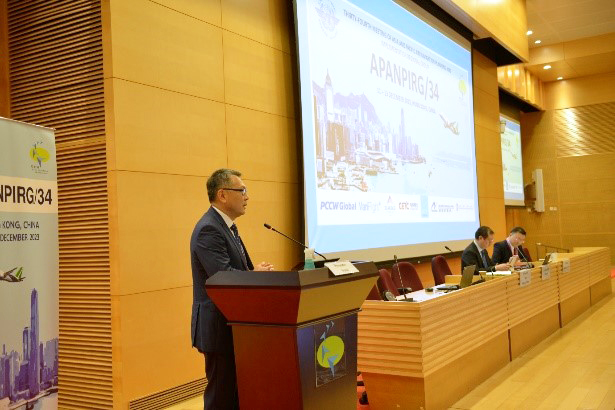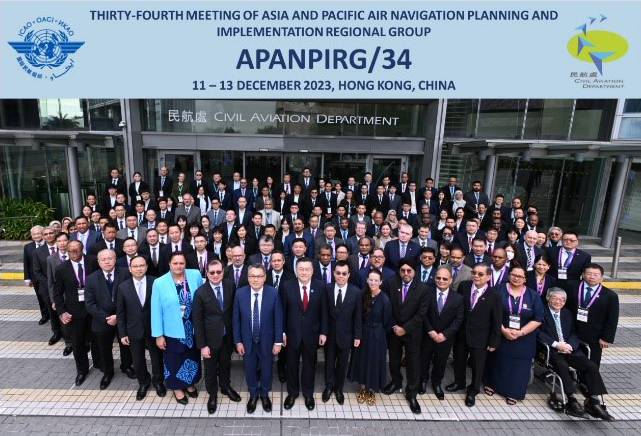The Air Traffic Management Division (ATMD) is responsible for the provision of air navigation services to civil aircraft operating within the Hong Kong Flight Information Region (HKFIR). The services include air traffic services, and search and rescue coordination. With a mission of providing safe, reliable and sustainable air navigation services, and maintaining efficient and orderly air traffic operations within the HKFIR, the ATMD is also responsible for the training of air traffic control (ATC) personnel, provision of aeronautical telecommunication services and design of the ATC procedures.
With air traffic gradually recovering from the pandemic, the ATMD will continue to closely monitor the traffic growth and provide safe and efficient ATC services in a dedicated and professional manner.
Air Traffic Operations
During this financial year, there were a total of 310 831 aircraft movements at the Hong Kong International Airport (HKIA) handled by the ATMD. In addition, the division handled 288 929 overflights transiting the HKFIR (46 750 of which were flights into and out of Macao International Airport). Amidst the progressive recovery of air traffic after the COVID-19 pandemic, aircraft movements at the HKIA and the number of overflights handled by the ATMD increased year-over-year by 90.77% and 118.44% respectively.
Runway Capacity
The ATMD will continue to closely monitor the air traffic demand situation and progressively increase the runway capacity to cater for traffic growth.
Validation and Revalidation Examinations of ATC Officer Ratings
Flight safety is of paramount importance in the ATC field. To ensure that the Civil Aviation Department maintains the safety standard, the ATMD's Training and Safety Section administered the validation examinations for the issuance of initial ATC qualification to Student Air Traffic Control Officers (SATCOs) according to a well-established mechanism. The ATMD's Operations Section also conducted regular revalidation examinations to verify the standard and competency of rated Air Traffic Control Officers (ATCOs). In the year, 207 validation and revalidation examinations were conducted in the four ATC streams, i.e. Aerodrome Control, Approach Control, Terminal Control and Area Control. On top of that, the ATMD also conducted examinations and issued certificates for officers who had attained other ATC-related qualifications, such as the ATC Meteorological Reporter Certificates, On-the-job Training Instructor Certificates and Flow Control Certificates.
Recruitment and Training of ATC Staff
Recruitment of Air Traffic Control Officers (ATCOs) and Air Traffic Flight Services Officers (ATFSOs)
To identify suitable candidates with potential in the ATC aspects and to ensure they are properly trained, the ATMD's Training and Safety Section has a comprehensive recruitment process and training plan for the ATC staff. A total of 29 SATCOs were recruited in batches and joined the CAD in the 2023-24 financial year. Another round of recruitment exercises will be launched in the coming financial year, with a target to recruit around 50 ATCOs III, SATCOs and ATFSOs III in total.
In addition, the ATMD periodically reviewed relevant tests in recruitment exercises for various posts to enhance the efficiency and effectiveness of recruitment operations. Since 2023, a new computerised recruitment tool has been deployed to speed up the SATCO recruitment process.
As at 31 March 2024, there were 354 ATCO grade and 138 ATFSO grade established posts in the CAD.
Training of SATCOs
To equip SATCOs with the required aviation knowledge, a series of well-designed training will be arranged for them after they joined the ATMD. They are required to complete the training programme, which comprises a number of modules at different stages, so as to perform operational ATC duties independently. To start with, SATCOs are provided with induction training to acquire basic aviation and ATC knowledge. They will then attend courses on basic ATC and basic flying knowledge as part of their professional training.
The basic ATC course aims to impart fundamental ATC knowledge and skills to SATCOs through theoretical and practical training to meet the training requirements set by the International Civil Aviation Organisation (ICAO). Throughout the years, the Hong Kong International Aviation Academy of the Airport Authority Hong Kong (AAHK) has provided local Basic ATC Courses for the SATCOs. Up to the end of March 2024, a total of 62 SATCOs have completed this local course. Courses on basic flying knowledge will also be arranged for SATCOs to broaden their exposure to various aspects of the ATC operations from the perspective of airspace users and to enhance their understanding of the basic principles of aircraft operations. As at the end of March 2024, a total of 42 SATCOs have completed the basic flying knowledge training which consisted of ground lectures and simulator flying provided by a local organisation.
To attain the ATC professional qualifications, SATCOs will then attend specialised ATC rating courses. In addition to classroom learning, there are practical simulator exercises in the ATC Surveillance Simulator or the Control Tower Simulator. Subject to satisfactory performance in the simulator practice, SATCOs will be given on-the-job training at operational working positions. During the training, SATCOs have to achieve the required standards to perform the ATC duties independently before they can be recommended for initial qualification checks. After passing the initial qualification check, a SATCO will progress to an ATCO III. To become a fully qualified air traffic control officer, i.e. an ATCO II, further specialised ATC rating training is indispensable. It normally takes around five to seven years for a SATCO to become an ATCO II.
Continuous Training for ATC staff
To ensure an uninterrupted supply of qualified ATC manpower, the ATMD developed a well-crafted training programme for the ATC personnel. The training programme is reviewed regularly to ensure operational needs are fulfilled and the anticipated air traffic growth can be coped with.
During this financial year, 41 professional ATC training courses were conducted and 72 ATC ratings or professional ATC qualifications were issued.
Furthermore, advanced training in various aspects, including project risk management, coaching and counselling skills, quality management, safety management and instrument flight procedure design, were also arranged for the ATC staff to equip them with the requisite knowledge to perform specialised duties.
As the ability of air traffic controllers to handle high volume of traffic and emergency situations is always of utmost importance, the ATMD has been arranging regular refresher simulator training in the year to ensure the competency of controllers and trainees under on-the-job training in handling various situations.
New ATC and Flight Procedures
ATC Operational Procedures for the Three-runway System
To tie in with the development of the Third-runway Project of HKIA, the new North Runway was opened in 2022. The Centre Runway, which was targeted for reopening by the end of 2024, was then temporarily closed for reconfiguration and the aerodrome operation officially transitioned to the Interim Two-runway System (I-2RS) mode. The New Air Traffic Control Tower (NAT) under construction is planned to operate in conjunction with the South Tower (S-TWR) in 2024 to provide aerodrome control services. The upcoming key milestone will be the transition of ATC operations from I-2RS to Three-runway System (3RS) operations.
In preparation for the transition of 3RS operations and the commissioning of the NAT, new ATC operational procedures have been developed in parallel with the new flight procedures and the 3RS airspace design. During the year, assessment and refinement of the 3RS airspace and operational procedures were conducted through fast-time simulation, real-time simulator evaluation and staff consultation. Furthermore, in order to manage these changes in a safe and comprehensive manner, and ensure compliance with the relevant regulatory requirements and standards, several safety workshops have been conducted with participation of frontline operational controllers, supervisors and stakeholders from the aviation community.
Besides, to apprise and acquaint ATC personnel with the 3RS operational procedures, a conversion training programme with various modules of training has been formulated in October 2023. The 3RS Conversion Training has commenced in December 2023 and will continue until October 2024, to ensure the operational readiness for a safe and seamless transition to 3RS operations.
Application of Approach Path Monitoring and Departure Path Monitoring to Support 3RS Operations in future
The use of Approach Path Monitoring (APM) and Departure Path Monitoring (DPM) by the CAD on the existing runways to detect departures and arrivals at the HKIA that deviate from the pre-defined flight paths has been very effective in preventing controlled flight into terrain since their implementation in 2019. The APM and DPM parameters associated with the new flight procedures to support 3RS operations have been developed and verified, and are ready to be deployed together with the upcoming 3RS system implementation.
Deployment of Digital Tower Facilities to Elevate Safety and Efficiency in the HKIA
Digital Tower Facilities (DTF) have been launched in the ATC Towers at the HKIA since July 2022. Equipped with ultra-high resolution cameras strategically positioned throughout the HKIA, the DTF provides real-time panoramic views to the ATC personnel, supplemented with augmented features such as correlation of flight data with aircraft and vehicle images. The inclusion of high-performance panoramic views in the DTF has significantly improved situational awareness for the ATC personnel, particularly in challenging conditions such as low-light and adverse weather scenarios. As a result, this enhancement has effectively bolstered the safety and efficiency of the ATC operations at the HKIA.
In order to support the upcoming 3RS operations, additional cameras have been deployed around the Centre Runway and the associated taxiways to provide full coverage of the HKIA.
The Design and Validation of Instrument Flight Procedures for the 3RS
In preparation for the target commencement of the 3RS operations of HKIA by the end of 2024, the design of the instrument flight procedures for the 3RS had been completed by the consultant appointed by Airport Authority Hong Kong (AAHK) in accordance with the standards and recommended practices established by ICAO. In order to ensure that all flight procedures met the prescribed standards, the ATMD conducted a series of ground validations on the new flight procedures, and collaborated with local airline operators to complete flight simulator evaluation in the fourth quarter of 2023. The ATMD also invited stakeholders to participate in safety risk assessment workshops and provide technical comments on the new flight procedures. The associated assessment process was completed in the first quarter of 2024.
In addition, the Flight Inspection Center (FIC) of the Civil Aviation Administration of China (CAAC) was commissioned to conduct flight validation on a portion of the 3RS flight procedures at the end of 2023. The results were satisfactory. Flight validation on the remaining flight procedures for 3RS operations is planned to be conducted in the third quarter of 2024. To this end, the ATMD will continue to coordinate closely with the parties concerned to complete the preparatory work as scheduled.
Approach Spacing Management System
The trial use of the new Approach Spacing Management System (ASMS) had commenced since early 2023 to provide ATCOs with an Approach Spacing Tool (AST) to enhance the consistent delivery of prescribed arrival spacing between aircraft. During the trial, multiple iterations of system software and adaptation updates were implemented to optimise ASMS performance and ATCOs had become fully competent in utilising the AST. Considerable improvement in operating efficiency concerning arrival flights to the HKIA was observed following the introduction of the AST. The trial operation of ASMS had been concluded with positive results upon a comprehensive review, taking into account the system performance, staff readiness and operating efficiency. Consequently, the ASMS commenced its full operation deployment at the end of March 2024.
Air Traffic Services
Coordination with Local Airspace Users
To promote flight safety, the Hong Kong Sector Flight Safety Committee comprising local airspace users continued to meet regularly to coordinate flight safety issues in the local low-level airspace. These local airspace users include fixed wing operators and rotary wing operators (the Government Flying Service, the People's Liberation Army Hong Kong Garrison (the Hong Kong Garrison), Sky Shuttle Helicopters Limited, Heliservices (Hong Kong) Limited and the Aviation Club of Hong Kong, China), Hong Kong Paragliding Association and private aircraft owners.
Aeronautical Search and Rescue (SAR) Coordination
The ATMD had organised a two-day Search and Rescue Exercise (SAREX) in November 2023 to provide continuous training for SAR qualified ATCOs and SAR units. The SAREX also provided the opportunity for all SAR units to familiarise themselves with SAR procedures, to foster cooperation and coordination among SAR units, and to promote technical exchanges to enhance efficiency in SAR operations.
The SAREX featured both short-range and long-range scenarios involving the CAD and seven other government departments, the Hong Kong Garrison, the Nanhai Rescue Bureau of the Ministry of Transport of the People's Republic of China, and the Guangdong Maritime Rescue Coordination Centre. Through collaboration of all professional parties, the SAREX was completed successfully with all objectives achieved.
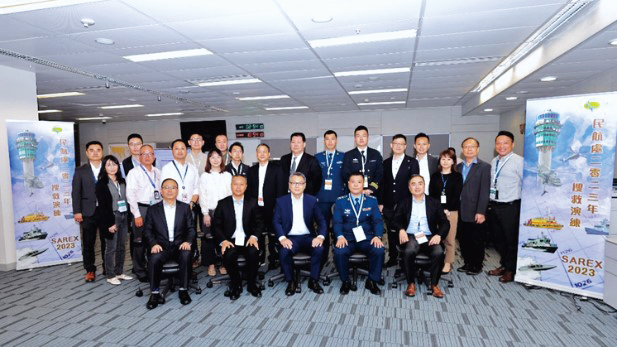
A joint two-day short and long range Search and Rescue Exercise (SAREX) organised by the CAD was successfully conducted with participation of seven government departments, the Chinese People's Liberation Army Hong Kong Garrison, the Nanhai Rescue Bureau of the Ministry of Transport of the People's Republic of China and Guangdong Maritime Rescue Coordination Centre.
Aeronautical Information Management
The Aeronautical Information Management Centre (AIMC) is responsible for the provision of aeronautical information to the aviation community in the form of aeronautical information products necessary for the safety, regularity and efficiency of air navigation. Aeronautical information products provided by the AIMC include the Aeronautical Information Publication (AIP), AIP Amendment, AIP Supplement, Aeronautical Information Circular, Notice to Airmen (NOTAM) and aeronautical charts. The AIMC is also responsible for processing flight plans for flights departing from the HKIA. All aeronautical information products are available on Hong Kong Aeronautical Information Services website (www.ais.gov.hk).
In the year, the AIMC handled 1 062 322 NOTAMs and 168 556 flight plans.
Telecommunications Services
The Aeronautical Network Centre (ANC) offers reliable, high quality and efficient telecommunication services for the exchange of air traffic service (ATS) messages and operational meteorological messages in support of air navigation services. In addition, the ANC provides 24-hour aeronautical broadcasting service by means of voice and digital dispatch to aircraft in flight for acquiring latest weather information necessary for flight operation. To ensure safe network security for the ATC systems, the ANC monitors firewall systems in real time and provides 24-hour network security alerting service.
In the year, the number of messages handled by the ANC was 86 039 504, a significant increase of 33% over the previous year. This growth was primarily contributed by the increased number of ATS messages associated with the traffic growth this year. On aeronautical broadcasting service, the number of operational meteorological messages dispatched to aircraft in flight was 343 593.
Looking ahead, the CAD is set to further extend the Common Aeronautical Virtual Private Network (CRV) by migrating the connection with Ho Chi Minh City from legacy point-to-point circuit to CRV by 2024. This addition, alongside the existing CRV circuits with Beijing, Bangkok, Fukuoka, Manila, and Taipei, will significantly enhance the efficiency and reliability of the Aeronautical Fixed Service provided by the ANC.
Air Traffic Flow Management for Asia-Pacific Region
The CAD has been actively participating in harmonising the Air Traffic Flow Management (ATFM) with other Air Navigation Service Providers (ANSPs) in the Asia-Pacific region. Working hand in hand, the CAD and the relevant authorities in Singapore, Thailand and Mainland China jointly developed the Distributed Multi-nodal ATFM network, a concept of Common Operational Procedure (COP) for the ATFM applicable to the Asia-Pacific region. The ICAO also adopted this concept in establishing a framework of cross border ATFM in the Asia-Pacific region with the participation of many Asia-Pacific countries, such as the Philippines, Vietnam, Malaysia, Indonesia, Cambodia and Korea.
The primary ATFM measure in the COP is the use of the Ground Delay Programme (GDP). It regulates the air traffic flow by allocating Calculated Take-Off Time to offset airborne delay, so as to solve the imbalance between demand and capacity of the airport and airspace caused by weather or other unpredicted events. Flights could be managed in a more organised manner, thus reducing fuel consumption and environmental pollution.
The CAD continues to act as a bridge between Northeast and Southeast Asia so as to promote the air traffic flow management in the Asia-Pacific region and to enhance the air navigation services for the entire Asia-Pacific region.
Air Traffic Management in the Guangdong-Hong Kong-Macao Greater Bay Area
To consolidate and enhance Hong Kong's status as an international aviation hub, and support the development of a world-class airport cluster in the Guangdong-Hong Kong-Macao Greater Bay Area (GBA), including the construction of the 3RS at the HKIA and the expansion of other airports in the GBA, the CAD has been working closely with the Air Traffic Management Bureau (ATMB) of the CAAC and the Civil Aviation Authority of the Macao Special Administrative Region (AACM) through the Tripartite Working Group (TWG) on ATM issues in the GBA. The objective is to jointly formulate appropriate measures, with a view to allowing every airport in the region to operate at their best efficiency. Over the years, a number of ATM enhancement measures have already been implemented, which optimised the air traffic flow and efficiency in the GBA and facilitated air traffic in the region to sustainably develop in a safe and orderly manner.
In the year, the TWG held a number of face-to-face and online conferences at various hierarchical levels to seek continuous enhancement of ATM initiatives. The TWG also proactively explored the application of new technologies by leveraging aircraft with more precise navigation performance in order to maximise the use of airspace resources in the GBA.
The CAD will keep collaborating with the ATMB of the CAAC and AACM through the TWG to actively study and implement various measures to optimise the GBA airspace management, with a view to enabling the 3RS of the HKIA to progressively achieve the target runway capacity of 102 air traffic movements per hour in the long run, and strengthening Hong Kong's status as an international and regional aviation hub.
Safety Management System
To mitigate and minimise safety risks during daily operations, the ATMD has implemented a comprehensive Safety Management System, with an aim to prioritise safety, enhance safety culture within the division, and continuously improve safety performance in Hong Kong airspace. According to risk management approach, various activities such as safety data collection and analysis are conducted in order to proactively identify potential safety issues. Appropriate risk mitigation measures and corrective actions may then be implemented in a timely manner to prevent the occurrence of safety related events.
The ATMD monitors safety performance continuously and compiles quarterly summaries, which are reviewed by the Air Traffic Management Standards Office, an independent regulatory office of air traffic management related matters. In addition, there is an internal audit programme for various key functional areas of the ATMD to ensure all operations are up to standards and the safety management requirements.
The ATMD will uphold safety risk management principles in managing various air traffic enhancement plans related to the 3RS project at the HKIA and other initiatives in the HKFIR to ensure that identified risks are mitigated properly.
Overseas Aeronautical Meetings and Conferences
Being one of the leading ANSPs in the Asia-Pacific region, the ATMD is committed to maintaining continuous and close collaboration with other ANSPs in the region through active participation in a variety of conferences and workshops convened by the ICAO, the Civil Air Navigation Services Organisation and other civil aviation authorities. The ICAO 34th Meeting of the Asia Pacific Air Navigation Planning and Implementation Regional Group, which served as an essential platform for enhancing ATM efficiency in the Asia-Pacific region and addressing regional challenges, was hosted by the CAD in December 2023. About 150 representatives from 26 Asia-Pacific States/Administrations, including the CAD, and seven international organisations attended the meeting and were engaged in productive discussions and presentations on a wide range of topics, including airspace management, air traffic flow management, aviation safety, and emerging technologies with milestones achieved. In the year, the ATMD also took part in various international meetings to share with industry partners valuable experience of implementing new ATM advancement initiatives, such as the ATFM for the Asia-Pacific region, and pressing ahead with significant ATM improvement initiatives like the introduction of enhanced longitudinal spacing on specific airways in the Asia-Pacific region, with an aim of enhancing ATM efficiency and ensuring seamless integration of important air navigation services upgrades.
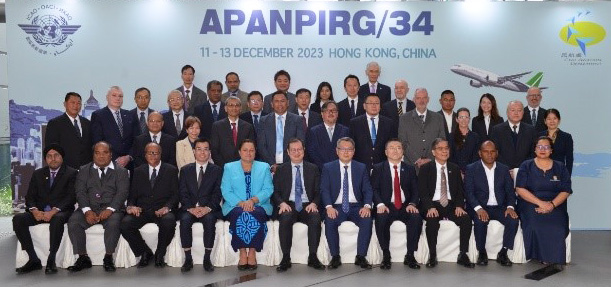
About 150 representatives from 26 Asia Pacific states and administrations and seven international organisations attended the ICAO 34th Meeting of the Asia Pacific Air Navigation Planning and Implementation Regional Group organised by the Hong Kong CAD at the CAD Headquarters. Productive discussions and presentations were conducted on a wide range of topics, including airspace management, air traffic flow management, aviation safety, and emerging technologies.


